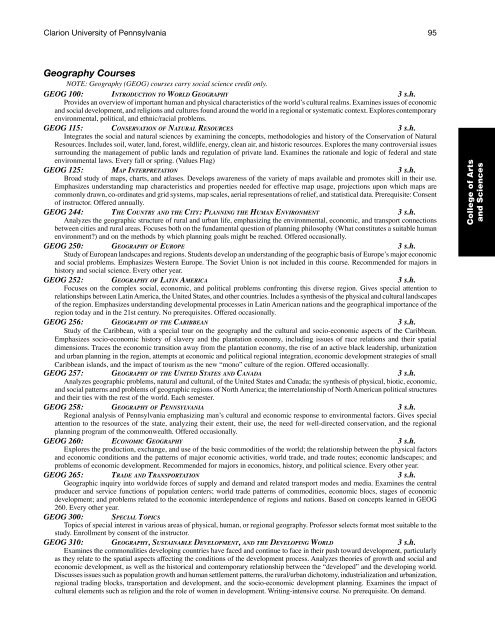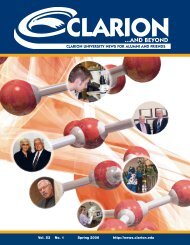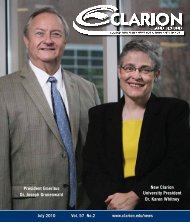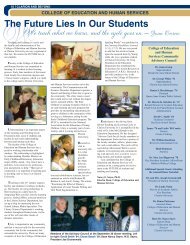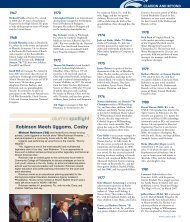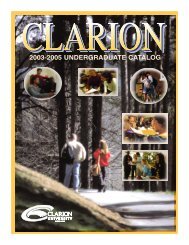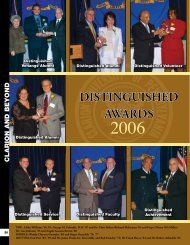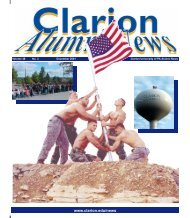Undergraduate - Clarion University
Undergraduate - Clarion University
Undergraduate - Clarion University
- No tags were found...
Create successful ePaper yourself
Turn your PDF publications into a flip-book with our unique Google optimized e-Paper software.
<strong>Clarion</strong> <strong>University</strong> of Pennsylvania 95Geography CoursesNOTE: Geography (GEOG) courses carry social science credit only.GEOG 100: Introduction to World Geography 3 s.h.Provides an overview of important human and physical characteristics of the world’s cultural realms. Examines issues of economicand social development, and religions and cultures found around the world in a regional or systematic context. Explores contemporaryenvironmental, political, and ethnic/racial problems.GEOG 115: Conservation of Natural Resources 3 s.h.Integrates the social and natural sciences by examining the concepts, methodologies and history of the Conservation of NaturalResources. Includes soil, water, land, forest, wildlife, energy, clean air, and historic resources. Explores the many controversial issuessurrounding the management of public lands and regulation of private land. Examines the rationale and logic of federal and stateenvironmental laws. Every fall or spring. (Values Flag)GEOG 125: Map Interpretation 3 s.h.Broad study of maps, charts, and atlases. Develops awareness of the variety of maps available and promotes skill in their use.Emphasizes understanding map characteristics and properties needed for effective map usage, projections upon which maps arecommonly drawn, co-ordinates and grid systems, map scales, aerial representations of relief, and statistical data. Prerequisite: Consentof instructor. Offered annually.GEOG 244: The Country and the City: Planning the Human Environment 3 s.h.Analyzes the geographic structure of rural and urban life, emphasizing the environmental, economic, and transport connectionsbetween cities and rural areas. Focuses both on the fundamental question of planning philosophy (What constitutes a suitable humanenvironment?) and on the methods by which planning goals might be reached. Offered occasionally.GEOG 250: Geography of Europe 3 s.h.Study of European landscapes and regions. Students develop an understanding of the geographic basis of Europe’s major economicand social problems. Emphasizes Western Europe. The Soviet Union is not included in this course. Recommended for majors inhistory and social science. Every other year.GEOG 252: Geography of Latin America 3 s.h.Focuses on the complex social, economic, and political problems confronting this diverse region. Gives special attention torelationships between Latin America, the United States, and other countries. Includes a synthesis of the physical and cultural landscapesof the region. Emphasizes understanding developmental processes in Latin American nations and the geographical importance of theregion today and in the 21st century. No prerequisites. Offered occasionally.GEOG 256: Geography of the Caribbean 3 s.h.Study of the Caribbean, with a special tour on the geography and the cultural and socio-economic aspects of the Caribbean.Emphasizes socio-economic history of slavery and the plantation economy, including issues of race relations and their spatialdimensions. Traces the economic transition away from the plantation economy, the rise of an active black leadership, urbanizationand urban planning in the region, attempts at economic and political regional integration, economic development strategies of smallCaribbean islands, and the impact of tourism as the new “mono” culture of the region. Offered occasionally.GEOG 257: Geography of the United States and Canada 3 s.h.Analyzes geographic problems, natural and cultural, of the United States and Canada; the synthesis of physical, biotic, economic,and social patterns and problems of geographic regions of North America; the interrelationship of North American political structuresand their ties with the rest of the world. Each semester.GEOG 258: Geography of Pennsylvania 3 s.h.Regional analysis of Pennsylvania emphasizing man’s cultural and economic response to environmental factors. Gives specialattention to the resources of the state, analyzing their extent, their use, the need for well-directed conservation, and the regionalplanning program of the commonwealth. Offered occasionally.GEOG 260: Economic Geography 3 s.h.Explores the production, exchange, and use of the basic commodities of the world; the relationship between the physical factorsand economic conditions and the patterns of major economic activities, world trade, and trade routes; economic landscapes; andproblems of economic development. Recommended for majors in economics, history, and political science. Every other year.GEOG 265: Trade and Transportation 3 s.h.Geographic inquiry into worldwide forces of supply and demand and related transport modes and media. Examines the centralproducer and service functions of population centers; world trade patterns of commodities, economic blocs, stages of economicdevelopment; and problems related to the economic interdependence of regions and nations. Based on concepts learned in GEOG260. Every other year.GEOG 300: Special TopicsTopics of special interest in various areas of physical, human, or regional geography. Professor selects format most suitable to thestudy. Enrollment by consent of the instructor.GEOG 310: Geography, Sustainable Development, and the Developing World 3 s.h.Examines the commonalities developing countries have faced and continue to face in their push toward development, particularlyas they relate to the spatial aspects affecting the conditions of the development process. Analyzes theories of growth and social andeconomic development, as well as the historical and contemporary relationship between the “developed” and the developing world.Discusses issues such as population growth and human settlement patterns, the rural/urban dichotomy, industrialization and urbanization,regional trading blocks, transportation and development, and the socio-economic development planning. Examines the impact ofcultural elements such as religion and the role of women in development. Writing-intensive course. No prerequisite. On demand.pages i-viiCollege of Artsand Sciences


